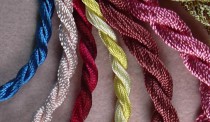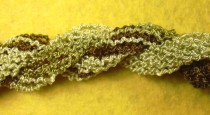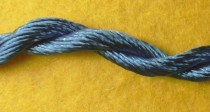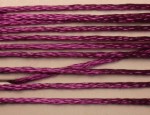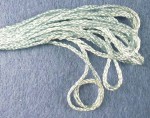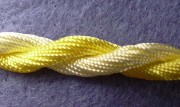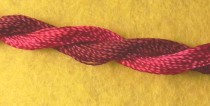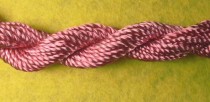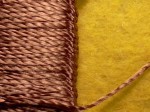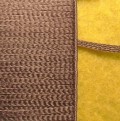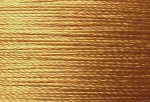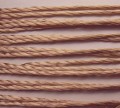Rayon Threads
Rayon, also called artificial silk, is a manufactured fiber which is neither natural nor synthetic fiber. (Rayon can be known as viscose, art silk or rayon. Many tags will read Rayon Viscose or Rayon.) Rayon fiber is made from wood pulp or cotton linters which go through a process of soaking, shredding, churned, dissolved, spun, washed, cut then worked into the desired thread. (This is the very shorten version of manufacturing rayon fibers.)
Most rayon threads are colorfast. But, as soon as a person says this, you will find one that will bleed when wet. This is because a large amount of dye was required for that particular color. When wet, the excess dye is released and travels onto other areas. Reds and blues are notorious for this. When this happens, quickly rinse water in that area until the unwanted dye is removed. This may take some time in doing so. To prevent, mount the canvas on stretcher bars. Always start with clean hands and new needles. Protect finished areas with a white cloth. When you are not working on your project, protect it by placing in a cloth bag or wrapped in white fabric.
To stitch with rayon, cut the required amount of and thread as usual. Cut a length no longer than 15” when working with rayon. You should separate the strands and place the required amount back together again. Use a needle slightly larger than required for your canvas size. Also, stitch like a sewing machine. Use up and down stab stitches as you sew. Please use a laying tool when working with rayon threads. Smooth stitches on the canvas will allow the rayon to catch the light and bring life into the motif. You may find the tails slippery when you start stitching. Try using an away knot. Stitch like normal and when you have finished, anchor the tail as needed. Do not use knots on the tails of your threads. Here is a hint: run the strands of rayon over a damp sponge and let dry. Never try to stitch the rayon when wet. The fibers will break, get tangled and create a mess! When I know I’ll be working with a large amount of rayon, I cut the skeins into workable lengths, run water through the strands while holding the middle of the length and then let drip dry.
To store your threads, place them in plastic bags. This will keep the threads clean and undamaged.
The Threads
Boucle` (boo-Clay): This beautiful thread is knobby, shiny and comes in an array of combination or solid colors. The thread has a 2-ply base with knobby loops incorporated in the twist to give dimension and interest. When you look at this thread, think of trees or ocean waves. Anywhere you would like dimension and pizazz, Boucle` is a good candidate. With a little practice, this thread will be a joy to work with. Boucle` is manufactured by EdMar and comes in a 10.5 yard skein.
Uses: Foliage, trees, water waves, over stitching for accents and clothes
Floss: When looking at rayon embroidery floss, you find a thread with a slight kink. Anchor Marlitt and DMC is available in a rainbow of colors. Discontinued companies like J & P Coats and Wescoflos can still be found but in limited quantities. Anchor skeins will come in 2-ply 4 strands while DMC will have 5 strands. Work the floss like you would cotton embroidery floss with the exceptions of those mentioned above in the general description.
Uses: All-purpose
Frost: Of all the EdMar threads, this one has the tightest twist. Because this is the case, a more definite pearl thread look will prevail on the canvas. Use Frost for details, flowers and other areas where you would like the eye to pop in that direction.
Uses: Details, flowers, clothes, evening wear and borders
Glory: This fine, very shiny thread is a 2-ply single strand thread which will be great for details or petit point. Glory, by EdMar is available in 240 colors. Some of the threads are solid colors and others are combinations. The skein has 21.5 yards which will be ample for smaller count canvas projects.
Uses: Details, eyes, flowers, water, gems, ice, high lighting, petit point
Neon Rays: Rainbow Gallery has created a rayon ribbon which is about 2mm wide. To rid the thread from kinks, run the ribbon over a damp sponge or iron it. Rainbow Gallery tells us Neon Rays may be “snapped” by pulling both ends to relax the fibers. A word of caution states, “The problem with this is that it will thin your length of fiber.” Also, use the stab method and laying tool when working with this thread.
Uses: Long stitches, clothes, foliage, embroidery stitches such as French Knots and Detached Chain
Nova: A 6-ply thread, Nova is the heaviest rayon thread EdMar makes. The appearance resembles a pearl thread and has a luxurious luster and shine. Use for gems, water, patent leather or other areas on the canvas where you would like to create a very high shine.
Uses: Jewels, water, eyes, bird feathers and bugs
Panache: This twisted rayon thread has a high shine which adapts very nicely to needlepoint canvas. Use it as it comes off the card. You may wish to run the thread over a damp sponge and let dry. This will release the creases. Use shorter lengths in the needle and use the stab stitching method. Rainbow Gallery recommends making twisted cords which should be couched on the canvas. The thread is slippery. Secure the ends tightly.
Uses: Jewels, tassels, cords, water, embroidery and decorative stitches
Patina: pearl rayon thread that can be used as-is or as multi-strand. Rainbow Gallery tells us, we can separate this 3-ply thread. The end result will resemble Japanese flat silk. Use shorter strands in the needle when doing so. Patina is a slippery thread. Secure the ends tightly.
Uses: Japanese motifs, kimonos, decorative and embroidery stitches


